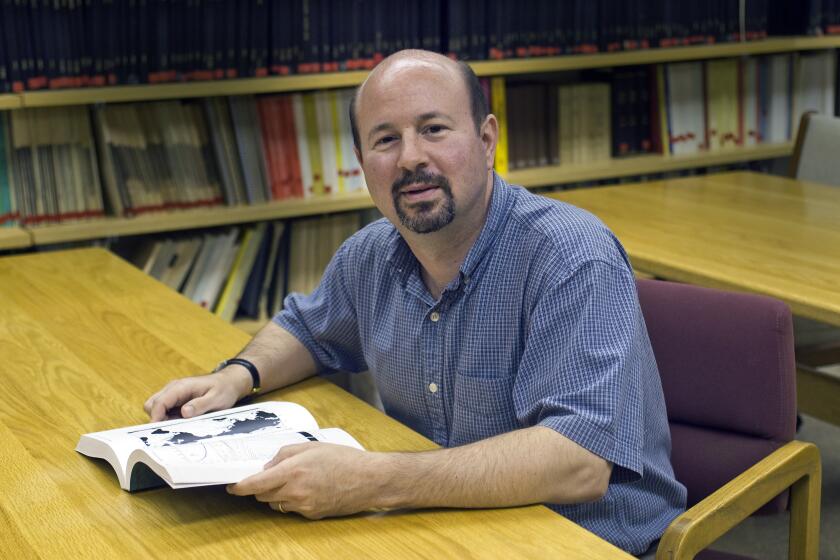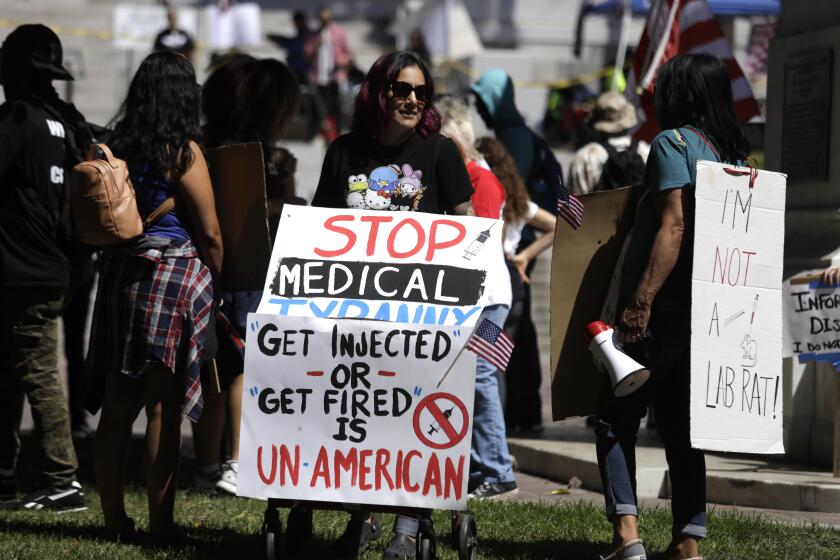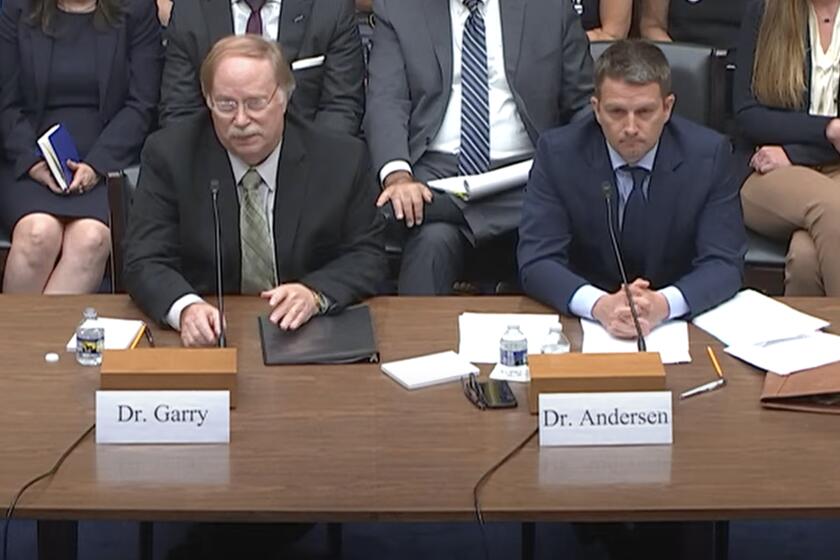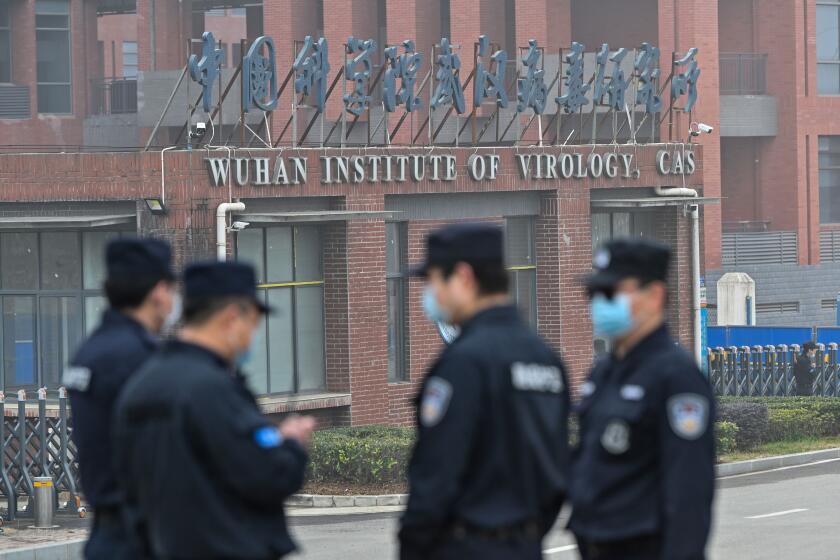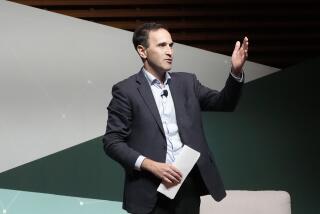Column: Two Rutgers professors are accused of poisoning the debate over COVID’s origins. Here’s why
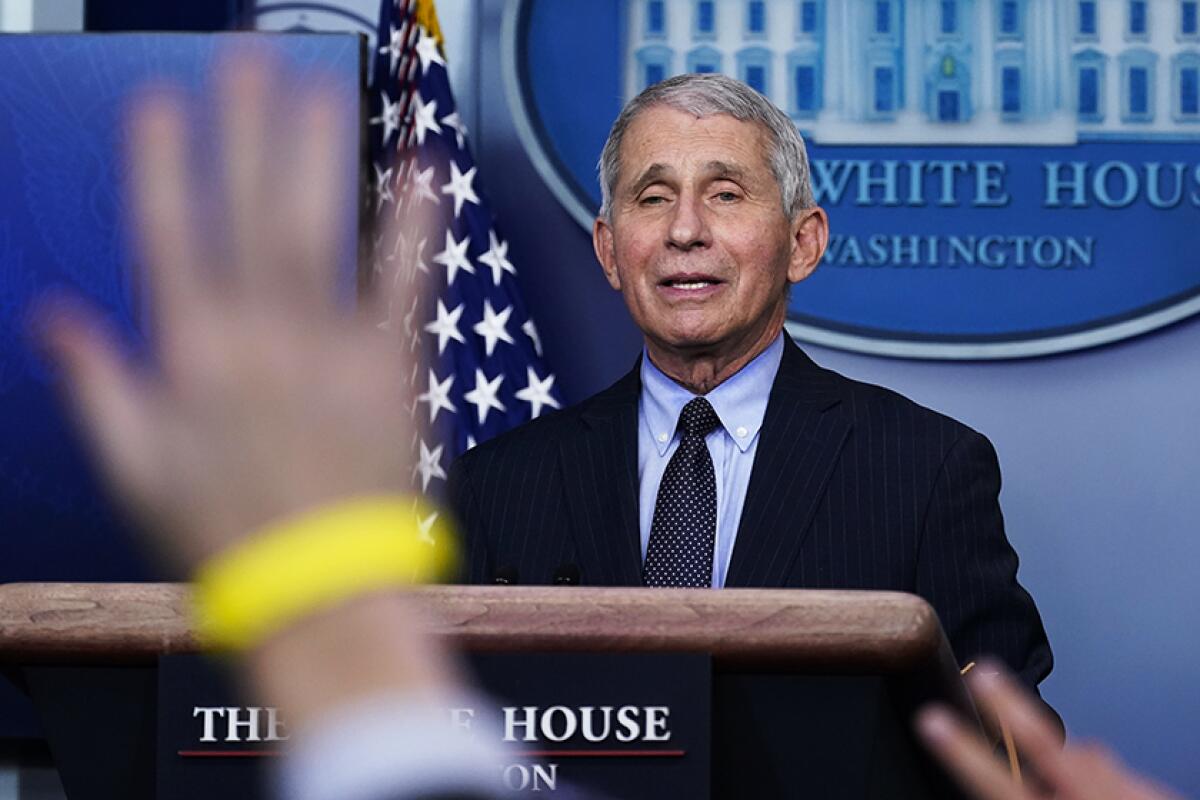
- Share via
In a Dec. 2 tweet, Richard H. Ebright, a professor of chemistry and chemical biology at Rutgers University, stated that Anthony Fauci, the respected virologist and retired official of the National Institutes of Health, “is likely a murderer and provably a felon.”
In another tweet a few weeks earlier, he had compared Fauci to the Cambodian dictator Pol Pot, who was responsible for the genocidal massacre of as many as 2 million people in the 1970s.
Referring to an event at Case Western Reserve University honoring Fauci, Ebright wrote: “You may have missed the chance to hobnob with Pol Pot, but, Case Western will give you the chance to hobnob with Fauci, whose policy violations ... likely killed 20 million.”
Every time I speak publicly, I now have a thought that there might be someone who has ingested this steady stream of distortions who might shoot me while I’m speaking.
— Michael Worobey, University of Arizona
In a tweet Aug. 25, 2022, Ebright’s colleague Bryce Nickels, a professor in the Rutgers department of genetics, called the “coordination” among virology researchers including Angela Rasmussen of the University of Saskatchewan and Michael Worobey of the University of Arizona an example of “pure, unfiltered evil.”
He illustrated the tweet with a GIF from the 1976 movie “Marathon Man” showing Dustin Hoffman being tortured by a character played by Lawrence Olivier and plainly inspired by Nazi doctor Josef Mengele.
This is the landscape on which a conflict over two theories about the origin of COVID-19 has been waged. One theory attributes the origin to unregulated trading in China of disease-susceptible wildlife, from which the virus that causes the disease is thought to have leaped to humans in a process known as a zoonotic spillover.
The other, the lab leak hypothesis, posits that the virus escaped from a virology lab in Wuhan, China, where it may have been deliberately concocted.
How a leading global warming scientist won $1 million from right-wing climate change deniers -- and gave heart to foes of pseudoscience everywhere.
Let’s be clear: There is no evidence for a lab leak. No one has ever produced anything in its favor other than innuendo and conjecture. By contrast, evidence for a zoonotic transfer is almost overwhelming, has grown ever stronger over the years and is widely accepted by virologists and epidemiologists.
Ebright and Nickels are advocates of the lab-leak theory. For years they have been posting online insinuations or outright accusations of fraud, perjury, felonies and murder aimed at scientists who advocate for the zoonotic transfer theory.
Now a dozen scientists, some of whom have been direct targets of Ebright and Nickels, have called on Rutgers to open a formal investigation into whether its two faculty members have crossed the line distinguishing between responsible scientific debate and defamation, harassment, intimidation and threats.
Among the concerns the signatories aired in their March 14 complaint letter is that the professors’ actions and “inflammatory language,” such as “comparisons of working scientists to historical war criminals and mass murderers,” could “put some of us and ... our colleagues in physical danger.”
Ebright’s and Nickels’ behavior, the complaint says, has unfolded in an atmosphere that had already produced “harassment including threats of death and/or violence because of our ... scientific research.”
Ebright and Nickels say the complaint misrepresents their words and activities. “I never have compared any of the signatories to Josef Mengele or Pol Pot, and I never have characterized any of the signatories as murderers,” Ebright told me by email. He adds, “I also never have threatened or incited violence against any of the signatories.”
He did acknowledge calling four signatories “fraudsters,” based on their authorship of a 2020 scientific paper that favored zoonosis as the origin of COVID-19 and dismissed the lab-leak theory as implausible. “I stand by this characterization,” he wrote. He called the complaint “an effort to silence opponents and to prop up a collapsing narrative.”
Nickels told me by email, “the assertion that I have labeled any of the 12 signatories as murderers or endangered them or their colleagues is false and is defamatory with malice.” In his email, he accused the same four signatories mentioned by Ebright of fraud.
The anti-vaccination and anti-science movements are killing thousands of innocent people. Why don’t government agencies and professional groups speak up?
More on that shortly.
The complaint letter says that Ebright and Nickels have engaged in online harassment, intimidation and threats for years. According to Kristian Andersen, an evolutionary biologist at Scripps Research in La Jolla and the organizer of the complaint, a new element in their approach recently appeared: encouraging their followers to engage in physical contact with zoonosis advocates.
On March 12, Nickels tweeted a notice of a scientific conference in Washington at which Peter Daszak, the head of a research funding organization who has long been the target of vituperation by lab-leak advocates, would appear on a panel.
“Don’t miss your chance to meet Peter Daszak, author of the grant many consider the ‘Blueprint’ for SARS-CoV2!” he wrote. The reference was to a groundless accusation beloved by lab-leak advocates that a grant proposal sponsored by Daszak’s organization involved creating a virus in a Chinese lab that became SARS-CoV-2, the virus that causes COVID. Virologists say the grant proposal would not have produced such a virus. In any event, it was not funded.
“That was so far outside of what I would consider to be normal and ethical conduct in science that I said, we need to file a formal complaint,” Andersen told me. The scientists’ letter to Rutgers administrators doesn’t ask for any disciplinary action, but calls for “immediate and serious review by the administration” of public behavior by Ebright and Nickels.
The call by Ebright and Nickels for followers to show up at a talk by Daszak stepped up the anxiety many scientists feel about their own public appearances.
“Every time I speak publicly, I now have a thought that there might be someone who has ingested this steady stream of distortions who might shoot me while I’m speaking,” says Worobey, a signatory of the complaint whose research helped to establish a seafood and wildlife market in Wuhan, not a lab, as the likely site of the first zoonosis transfers. “With those escalations recently, I thought it was time to deal with it head-on.”
Vaccine science, immigration and elections are all battlegrounds for the war between information and disinformation today. The temperature of debates on these topics is only heightened by the tendency of social media platforms such as Twitter (now X) to encourage intemperate speech. But science and health seem to be areas especially vulnerable to efforts at falsification.
A brief primer on the lab-leak hypothesis may be useful here. During the earliest weeks of the COVID pandemic, many virologists examining the SARS-CoV-2 virus, including Andersen, spotted unfamiliar features, some so unusual that they conjectured the features might have been man-made.
House Republicans used an oversight hearing to accuse former NIH officials Anthony Fauci and Francis Collins of complicity in the COVID pandemic. The loser in this cabaret is science.
Further research in the ensuing weeks revealed, however, that these features were not unusual, but common, and that they could develop in viruses such as SARS2 through natural processes. Andersen and others eventually concluded that a laboratory role in COVID’s emergence was implausible.
That conclusion was written into a seminal paper on the virus published in Nature Medicine on March 17, 2020, and titled “The proximal origin of SARS-CoV-2.” Its authors included Andersen, Robert F. Garry of Tulane University, Andrew Rambaut of the University of Edinburgh and Edward C. Holmes of the University of Sydney.
All four signed the complaint letter to Rutgers. They’re the four scientists Ebright and Nickels accused of fraud in their emails to me, based on the Rutgers scientists’ claim that the proximal origin paper was fashioned to serve what Ebright and Nickels assert was the authors’ and Fauci’s desire to downplay
Fauci’s role in funding virology research in China.
Ebright further accused Andersen and Garry of perjury, based on their denials at a congressional hearing in July that Fauci pressured them to advocate for the zoonosis theory in their paper.
After the paper’s publication, the lab-leak hypothesis moved into the partisan political realm. Republicans in Congress cherish the notion that Andersen and his colleagues deliberately minimized a laboratory role at Fauci’s behest.
There is not a scintilla of evidence for that assertion, as Andersen and Garry made clear by cogently explaining at the July hearing called by conspiracy-addled House Republicans how the normal process of scientific research led them to the paper’s conclusions.
Last March, FBI Director Christopher Wray stated in an interview with Fox News that the bureau had concluded with “moderate confidence” that the virus had escaped from the Chinese lab, but he cited no evidence and didn’t explain its grounds.
The FBI’s assessment had been part of a survey of all U.S. intelligence agencies that largely contradicted the FBI’s position. In June, it was further contradicted by a report from the Office of the Director of National Intelligence, which refuted claims that the Chinese lab had played a role in the pandemic.
That brings us back to Ebright and Nickels. Although insults and invective are hardly uncommon in exchanges over COVID’s origins, their contributions have often carried a remarkably noxious tone.
The defense by both that they never compared the complainants to Pol Pot or Mengele or characterized them as murderers may be true as far as it goes. But it’s too clever by half. The complainants didn’t say in their letter to Rutgers that they themselves were necessarily the targets of Ebright’s and Nickels’ odious comparisons. Their complaint says the pair had “made comparisons of working scientists” — i.e., other scientists — “to historical war criminals and mass murderers.”
So let’s look at the record.
A long-awaited government intelligence report suggests that COVID didn’t come from a Chinese lab, but don’t expect conspiracy-mongers to be satisfied.
Ebright has repeatedly intimated that Fauci is a murderer, based on his view that his agency funded dangerous virology research in the Chinese lab that produced the pandemic. There is no evidence that any research the U.S. government funded in China produced the SARS-CoV-2 virus, or even that any such research at that lab was scientifically possible.
On Nov. 13, Ebright wrote of Fauci, “any person whose violations of U.S. government policies ... resulted in 20 million deaths is, by any rational standard, a murderer.” It’s unclear what “violations” he was referring to.
In a June 27 tweet, Ebright described Fauci as “an octogenarian serially misfeasant, serially malfeasant, serially perjurious, former bureaucrat likely to face criminal charges after Jan 2025” (i.e., presumably assuming that Donald Trump would then take office again).
On Dec. 23 he tweeted that the “only option” to “mitigate the negative effects” of the proximal origin paper was the referral of Andersen and his colleagues “for criminal prosecution.”
On July 10, 2021, Ebright responded with the following comment to a tweet that apparently had alluded to critics of the lab-leak theory: “Sociopaths will be sociopaths ... See Mengele. See Ishii.” The latter reference is to Shirō Ishii, who headed Japan’s World War II bioweapons program, which has been blamed for the deaths of as many as 300,000 people.
On Sept. 5 and 6, 2022, Ebright summarized the case for the lab-leak hypothesis, which he tied to “labs conducting world’s largest research program on bat SARS-like coronaviruses.” He ended the thread with the phrase “The banality of evil” — philosopher Hannah Arendt’s description of the impression left on her by Adolph Eichmann, the architect of the Nazi program of Jewish genocide, whose trial in Israel she reported on.
Nickels, in addition to posting the Mengele-linked film clip, earlier this month tweeted “massive respect to ... military veterans that have taken a stand” against scientists he asserted had lied about research “impacting national security.” He called the behavior of such scientists “treasonous” and he specifically named among those deserving respect, one Andrew G. Huff.
One day earlier, Huff, who labels the zoonosis theory a “lie,” tweeted a call for Fauci, Daszak and virologist Ralph Baric of the University of North Carolina to be hauled before a military tribunal. Subsequently, he tweeted that his followers had voted in an online poll that if convicted, they should be hanged. He illustrated that tweet with a film clip of three people plunging to their deaths on a gallows.
The ball is now in Rutgers’ court. The university says the complaint “will be forwarded to the appropriate offices for review.” It didn’t say what issues would be considered. But certainly a determination would be warranted of whether its faculty members’ actions conform to the school’s policy on free expression, which frowns on actions or behaviors that “threaten individuals or cause an injury to someone” or “harass, threaten violence, or intimidate others.”
Whatever the outcome is of any such inquiry, the scientific community is right to be appalled by Ebright’s and Nickels’ activities. There’s vast latitude in science for disagreement and debate, but calling one’s adversaries or critics criminals or traitors, or placing them in the same category as Mengele, Eichmann and Pol Pot? That isn’t scientific debate.
In the world of science, the reputations of Andersen, Worobey, Garry, Holmes and Rambaut are secure; their finding that COVID most likely originated in the wildlife trade has not only held up over time but also been validated by subsequent studies. The same is true of the other eight signatories of the complaint letter, and Fauci and Daszak (who are not signatories).
Ebright and Nickels? They may be a different story.
More to Read
Get the latest from Michael Hiltzik
Commentary on economics and more from a Pulitzer Prize winner.
You may occasionally receive promotional content from the Los Angeles Times.

